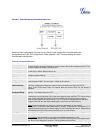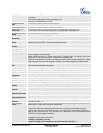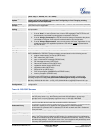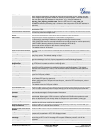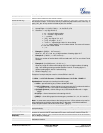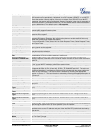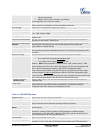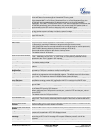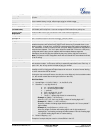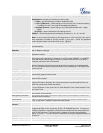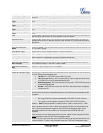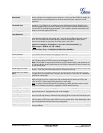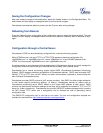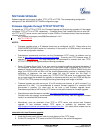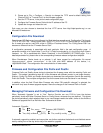
Grandstream Networks, Inc. HT503 User Manual Page 30 of 38
Firmware 1.0.4.2 Last Updated: 06/2011
according to the STUN client specification. Using this mode, the embedded STUN
client will detect if and what type of firewall/NAT is being used.
If the detected NAT is a Full Cone, Restricted Cone, or a Port-Restricted Cone, the
HT503 will use its mapped public IP address and port in all of its SIP and SDP
messages. If the NAT Traversal field is set to “Yes” with no specified STUN server, the
HT503 will periodically (every 20 seconds or so) send a blank UDP packet (with no
payload data) to the SIP server to keep the “hole” on the NAT open.
SIP User ID
User account information, provided by VoIP service provider (ITSP). Usually in the form
of digit similar to phone number or actually a phone number.
Authenticate ID
The SIP service subscriber’s ID used for authentication. Can be identical to or different
from SIP User ID.
Authenticate Password
SIP service subscriber’s account password.
Name
SIP service subscriber’s name for Caller ID display.
DNS mode
One from the 3 modes available for “DNS Mode” configuration:
-A Record (for resolving IP Address of target according to domain name)
-SRV (DNS SRV resource records indicates how to find services for various protocols)
-NAPTR/SRV (Naming Authority Pointer according to RFC 2915)
One mode can be chosen for the client to look up server.
The default value is “A Record”.
User ID is Phone Numbe
r
If the HT503 has an assigned PSTN telephone number, this field should be set to
“Yes”. Otherwise, set it to “No”. If “Yes” is set, a “user=phone” parameter will be
attached to the “From” header in SIP request.
SIP Registration
Controls whether the HT503 needs to send REGISTER messages to the proxy server.
The default setting is Yes.
Unregister on Reboot Default is No. If set to Yes, the SIP user’s registration information will be cleared on
reboot.
Outgoing Call Without
Registration
Default is No. If set to “Yes,” user can place outgoing calls even when not registered (if
allowed by ITSP) but is unable to receive incoming calls.
Register Expiration
This parameter allows the user to specify the time frequency (in minutes) the HT503
refreshes its registration with the specified registrar. The default interval is 60 minutes
(or 1 hour). The maximum interval is 65535 minutes (about 45 days).
SIP registration failure
retry wait time
This parameters allows the user to specify the time frame (in seconds) the HT503 will
wait before sending another SIP registration INVITE in case the first INVITE fails.
Local SIP Port
Defines the local SIP port the HT503 will listen and transmit. The default value for FXS
port is 5062.
Local RTP Port
This parameter defines the local RTP-RTCP port pair used by the HandyTone ATA. It
is the base RTP port for FXO channel.
When configured, the FXO port will use this port _value for RTP and the port_value+1
for its RTCP.
The default value for FXO port is 5012.
Use Random Port
This parameter forces the random generation of both the local SIP and RTP ports when
set to Yes. This is usually necessary when multiple HT503 units are behind the same
NAT.
Refer to Use Target
Contact
Default is No. If set to YES, then for Attended Transfer, the “Refer-To” header uses the
transferred target’s contact header information.
Remove OBP from Route
Header
Default is No. If set to Yes, the Outbound Proxy will be removed from the route header.
Support SIP instance ID Default is Yes. If set to Yes, the contact header in REGISTER request will contain SIP
Instance ID as defined in IETF SIP Outbound draft.
V
alidate incoming
message
Default is No. If set to yes all incoming SIP messages will be strictly validated
according to RFC rules. If message will not pass validation process, call will be
rejected.
Check SIP User ID for
Default is No. Check the incoming SIP User ID in Request URI. If they don’t match, the



